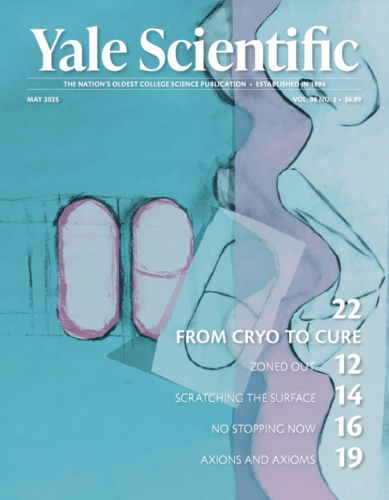The beauty and the nuisance of modern science is that the number of questions we can pose stands far in excess of the number we have the resources to answer. Now, as federal agencies curtail research initiatives and university budgets tighten, the challenge of allocating resources is all the more severe. A scientist writing a grant proposal in the hopes of funding a new scientific endeavor must contend with questions that are equal parts philosophical and economic—chief among them: Why does this project matter?
One perspective suggests that a scientific project is worthwhile if it will improve people’s lives. In this issue’s cover story, “From Cryo to Cure” (p. 22), researchers explore a neuron-transplant therapy that could restore brain function and enable longer, healthier lives for patients with neurodegenerative diseases. In the winning article from the Yale Scientific’s recent national essay contest, “The Fight Against the Flood” (p. 27), high school student Victor Gonzalez paints vignettes of climate resilience as Houston’s engineers and environmental scientists respond to a changing climate. From medicine to engineering, the utility of science is apparent: As a systematized expression of human curiosity, science grapples with the unruly phenomena of the natural world to yield useful solutions.
At the same time, though, science is not merely a process of problem-solving. The scientific method stems from intuition and observation, and in the end it seeks to broaden the scope of humanity’s knowledge. “Axions and Axioms” (p. 19) chronicles Yale scientists’ search for an elusive particle that lies at the heart of foundational questions in theoretical physics and astrophysics. The reward for such fundamental work is often oblique, but it is no less valuable. Advances in fundamental science give humanity a glimpse into the inner workings of nature. We broaden our knowledge as we learn to speak fluently the language of the universe.
In this way, science serves a role similar to that of the arts, extending the possibilities for what can be known through its fragmentary innovations. In this issue’s undergraduate profile (p. 34), we meet field ecologist and writer Molly Hill (YC ’25), whose studies on the intricacies of bird behavior intertwine with artistic expression in her creative projects and advocacy. Research like Molly’s is imperative for the gradual accumulation of knowledge that marks the advancement of society—like art, its value lies in its chronicling of the minutiae that make up life, nature, and the world. In the end, it is part of a great symphony shared by all.
The team behind this issue of the Yale Scientific Magazine hopes that we play a role, too, in the positive force that is scientific practice. Thank you to the Yale Science & Engineering Association and to our subscribers from around the world who make it possible for us to tell the stories contained in these pages. The Yale Scientific remains eyewitness to centuries of science at Yale.

